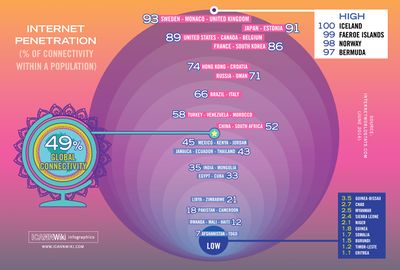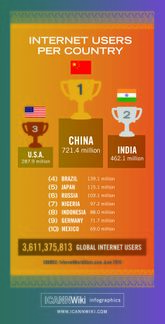ICANN 57 Quickie
Thanks for picking up the third edition of the ICANNWiki Quickie, an indispensable guide to ICANN57 in Hyderabad, India. Like ICANNWiki, this guide was built from the bottom-up. For instance, insteading of adding to the abundance of literature available on the IANA Transition, we decided to reach out directly to different stakeholders across the globe to get their thoughts on the transition. That is just one great example of how we approach the Quickie--we share what we know, learn from each other and move forward as one toward a meaningful and productive meeting.
Inside you’ll find an explanation of the many acronyms found in ICANN, primers of relevant topics, a new guide to visual editing on the wiki, fantastic infographics and much more!
ICANN 57 - Quickie -- DOWNLOAD .PDF
Infographics
Ever since ICANN55 in Marrakech, ICANNWiki has been visually representing data sets with our exciting new infographics. Our latest batch analyzes global internet connectivity trends, and includes a subtle focus on India. Click here to see more ICANNWiki Infographics.
IANA Transition
There is an abundance of amazing content available surrounding the IANA Transition, and rightfully so. It has been a primary focal point of the community for the past two years. It was great to see the community taking the initiative to educate the world about the importance of the transition, especially when things became increasingly contentious.
In the ICANNWiki Quickie, we’ve decided to take a different approach. We wanted to focus on people from the global community who will benefit from transition, and let them tell the story.
IANA Transition: A Milestone Worth Celebrating
By Donna Austin - Policy and Industry Affairs Manager, Neustar
The announcement[1] that the transition of IANA functions to ICANN would indeed go ahead as planned resulted in a virtual round of congratulatory messages along with an almost audible collective sigh of relief from the global Internet community.
Since March 2014 the ICANN community, Board and the organization, has been consumed by activities associated with the transition. Countless parties from around the world have worked tirelessly to establish the necessary processes, bodies and measures required to ensure this transition could take place.
As Lawrence Strickling explained in his testimony[2] to the Senate hearing on Protecting Internet Freedom, reaching this milestone involved “more than 26,000 working hours” developing the IANA Stewardship Transition Proposal, “more than 33,000 messages on mailing lists” and “more than 600 meetings and calls”. The sheer magnitude of these numbers alone indicate the significance of this event and this work cannot go without congratulations and thanks.
On a personal note, I am grateful to have been a part Cross Community Working Group on IANA Transition, representing the Registry Stakeholder Group, that was responsible for developing the IANA Transition Proposal; and equally grateful that after more than two years of hard work our product was considered acceptable by the US Government. My colleague, Becky Burr, was also closely involved in the CCWG on Accountability, whose work was an integral component of the path to transition.
I extend my congratulations to all those in the global Internet community who have helped reach this significant milestone. This is just the beginning of an equally challenging and exciting task ahead, but it is certainly an achievement of which our entire community should be proud and testament to the multistakeholder model upon which ICANN was founded.
IANA Ironies
By Steve Crocker - Chair, ICANN Board of Directors
"No one expected addressing and naming to be either difficult or contentious. Close to fifty years ago, when the early network visionaries focused on transforming computer-to-computer communication and opening up an untold range of applications, no one paid any attention to the “minor” details of addressing and naming. As the Internet exploded in the 1990s. the naming system had become a very big deal. The small and fairly informal process Jon Postel had been carrying out on behalf of the community needed a more formal structure. ICANN was born in late 1998 with the explicit task of housing the IANA function. The U.S. Government intended to oversee ICANN’s execution of the IANA just temporarily. “Temporarily” was estimated to be about two years. Eighteen years later, the U.S. Government has finally stepped back from its role of overseeing ICANN. We – and by “we” I mean the entire global Internet community – are now in charge of the system. It is both nothing and everything. Internet users saw no change in the operation of the Internet when the IANA contract came to an end. On the other hand, we have now embarked on a whole new phase in governance of identifier system of the Internet. I think we’re in very good shape, but I wonder what our successors say 20 and 50 years from now."
Personal Testimonials
"The last day of October 2016 marked a date which the Global South watched with great expectation. I was in LACNIC 26/LACNOG 16 for my first time. One of the greatest events of internet governance in the region, further energized by the announcement of this date: the official date when the IANA contract with the US government ended. This was the moment when ICANN became in control of the “Internet’s address book”.
Up until the last minute of confirmation of the transition, LACNIC joined over 200 people in a hotel auditorium in Costa Rica. At this yearly meeting, technical and economical themes about the internet market are discussed. But that week, something seemed very different. The IANA transition was in everyone’s mind. The new team for IANA ended the day with a round of applause and celebration. The internet belongs to all and the excitement to have this guaranteed was in everyone’s mind. So next steps do predict a lot of work but collaborative work, as our collective richness of knowledge online should have.""The IANA transition event means nothing: it’s what we now do with it that counts.
History is replete with independence movements that culminated in disarray. To succeed, hard-won independence must be followed with responsible and disciplined actions. Actions that reflect the very values that fueled the independence movement in the first place.
Throughout this long and difficult process, the ICANN community showed its resilience and unequivocal readiness to take charge of its new weighty responsibilities. I have no doubt that our community will rise to the challenge of implementing the operational and accountability frameworks we all designed together. The eyes of the broader global community are monitoring our progress: failure will impact much more than the ICANN community, strengthening those who believe in top-down governance for the digital space and beyond.
Watching ICANN soar to the necessary heights of responsibility, accountability, and inclusivity will mean the most to me and to everyone who longs to see transnational governance working."Primers
ICANNWiki Primers familiarize you with important concepts in the Internet Governance space.
Universal Acceptance
How to Get the Next Billion Online: Be Part of the Fight for Universal Acceptance
This article was provided by UASG Universal Acceptance (Steering Group).
3.2 billion people are online worldwide, according to the International Telecommunication Union (ITU), and around 45 percent of all households have access to the Internet. Despite these impressive figures, it has only been recently since people with languages based on non-Latin alphabets have started being able to use the Internet to its fullest extent in their mother tongue. This is a result of the Domain Name System (DNS) supporting non-ASCII characters in domain names, more specifically support for Unicode characters in internationalized domain names (IDN) and e-mail address internationalization (EAI).
Though Internationalized domain names and e-mail addresses now exist for multiple languages and alphabets – e.g. Han, Cyrillic, Hangul, Thai, Arabic, Hebrew and Greek – help is still needed from the community to bring the rest of the systems that touch the Internet up to modern standards, to achieve what is now known as Universal Acceptance. To achieve Universal Acceptance, Internet applications and systems must treat all TLDs in a consistent manner, including new gTLDs and internationalized TLDs. Specifically, they must accept, validate, store, process and display all domain names.
A large portion of the software and systems that the Internet relies upon today are not yet compliant with the standards of Universal Acceptance. Not all online portals are primed for the opening of a user account with one of these new e-mail addresses. While filling out online forms, Top-level domains that exceed the previous standard length of two or three characters and e-mail addresses that are based on unicode are not always accepted. To give you one example: Over 90% of all websites tested accept our ASCII@new-four-character-TLD, but less than 5% accept our unicode@idn.idn!
The Universal Acceptance Steering Group (UASG) is an Internet community initiative that was founded in February 2015 and tasked with undertaking activities that will effectively promote the Universal Acceptance of all valid domain names and email addresses. The group is made up of members from more than 120 companies (including Apple, GoDaddy, Google, Microsoft and Verisign), governments and community groups. The UASG receives significant financial and administrative support from ICANN.
Internet Service Providers are one of the cornerstones of the Internet Industry. Every e-mail, every request to show a website passes your systems on the application level. This is why the UASG is encouraging you to get all of your systems UA-ready and we seek your support to accomplish the UASG´s mission. A big first step would be to create a clearer picture of the status quo: How many UA issues do you, your engineers and your support staff receive per day, week or month? Share your experience with us and the industry. The UASG is working on an issue logging system to gather, structure and aggregate information to direct your and our resources in the right direction.
We are particularly looking for ISPs to get involved not only from North America and Europe but from other parts of the world where internationalized domain names and e-mail addresses based on non-Latin scrips are more common. The UASG has developed core documentation to support your efforts and to help developers getting their tools and programming languages UA-ready.
UNIVERSAL ACCEPTANCE STEERING GROUP WORKSHOP
Thursday, November 3 09:00 - 13:45
Room: G.01/02
Public Technical Identifiers (PTI)
The “Post-Transition IANA” organization, or Public Technical Identifiers (PTI), was formed on 11 August 2016 to become the new IANA Functions Operator following the IANA Functions Stewardship Transition, which successfully took place on 01 October 2016. It was incorporated as a separate legal entity and affiliate of ICANN. To ensure a smooth transition, the existing employees of the IANA department transitioned into a role at PTI to perform the IANA Functions. PTI also consists of five board members, three of which are appointed by ICANN and two by the Nominating Committee starting in 2017.
PTI is granted the right to perform the IANA Naming function through the Naming Function Agreement with ICANN. Creating a separate legal entity, rather than maintaining IANA as a department of ICANN, had several benefits. It allowed for a contract between PTI and ICANN allowing potential separation through non-renewal of the contract if necessary, and it maintains a clear and functional separation between the policy development and the implementation of the policy.
To ensure coherence of the IANA Functions and overall operational logistics, PTI also performs the IANA functions relating to the numbering registry and protocol parameter registry through subcontracts with ICANN who has direct agreements with the number and protocol communities. ICANN also subcontracts to PTI the responsibility to fulfill ICANN’s obligations under the Root Zone Maintainer Agreement (RZMA) with Verisign and to monitor Verisign’s performance of its obligations.
In addition to the Naming Function Agreement and the subcontracts for the naming, protocol and RZMA related services, ICANN and PTI entered into a Services Agreement which sets forth the role that ICANN plays in the composition of the staff and board, as well as ICANN’s provision of services and resources to PTI.
To replace the now historical oversight role of the NTIA, the Customer Standing Committee (CSC) was formed. The CSC will ensure satisfactory performance of the IANA naming function as it relates to the direct customers of these services by analyzing monthly performance reports. Additional oversight will be provided by an IFR process, which is empowered to conduct periodic and special reviews of the IANA naming functions. In extreme circumstances, a Special IFR can determine the need for a separation of ICANN and PTI and recommend that a working group be established to review the issues and recommend the next steps.
Ultimately, it was a smooth transition and the vast majority of people had no idea that this transition occurred. The DNS is as secure, stable, and resilient as ever.
WHOIS & Next-Gen RD
WHOIS hasn’t changed much since it’s conception in the early 1980’s, but the Internet certainly has. WHOIS was originally established as a directory of contact information for anyone using the ARPANET. As things evolved and the Internet became a global, commercial resource, the usage of WHOIS changed dramatically, but the protocol itself remained mostly unchanged. Consequently, it has become a source of perennial debate and discussion.
Why It Matters
In 2012, the WHOIS Policy Review Team (WHOIS RT) released its final report, which included 16 recommendations to ensure that WHOIS policy and implementation is effective, meets the legitimate needs of law enforcement and promotes consumer trust. Among the most pressing issues that have come to the forefront are accuracy, privacy, privacy/proxy services, purpose and access, among other things.
Many of these have been addressed at some level, but the community is still seeking comprehensive reform to provide a solution that adequately addresses all of the major concerns around WHOIS.
ACCURACY has always been considered important. If the purpose of the system is to enable others to contact the registrant, it is important that the provided contact details are correct. During the ARPANET days if a node failed, it was important to be able to contact the administrator. Now, it is important to a variety of stakeholders such as law enforcement and others who seek to prevent domain abuses.
PRIVACY, as it relates to the Internet, is becoming an increasingly important subject and WHOIS policy is no exception. The evolution of the purpose of WHOIS has changed, being used for both legitimate and malicious reasons.
PRIVACY AND PROXY SERVICES have partially been a response to the privacy concerns inherent to the WHOIS system, enabling domain name registrants to keep their personal information private by providing the services information in its place to meet ICANN requirements.
PURPOSE, as it relates to WHOIS, is a complicated issues. A wide variety of stakeholders use WHOIS for different reasons, nearly all of which differ from its originally intended purpose. In 2012, the Security and Stability Advisory Committee (SSAC) issued a response to the WHOIS RT’s report, underlining the importance of “understanding the purpose of domain name registration data” before a comprehensive solution can be found.
Policy Work
After the WHOIS RT’s Final Report and the SSAC’s response in 2012, the ICANN Board resolved to take a two-pronged approach: 1) enhancing existing policies 2) reexamining the purpose of domain name registration data and considering safeguards for that data.
On Track 1, the majority of the work has been completed, including issues relating to compliance, accuracy, access, and internationalization. Remaining issues include the implementation of policies relating to Thick WHOIS and Privacy/Proxy Accreditation.
On Track 2, the Policy Development Process on Next-Generation gTLD Registration Directory Services to Replace Whois (RDS PDP) is in Phase 1, in which it will identify the fundamental requirements for registration data and determine if the requirements can be met by WHOIS or if a Next-Gen Registration Directory Services (RDS) is necessary. Phase 2 will recommend policies to meet the requirements of Phase 1 and Phase 3 will create implementation and coexistence guidance for the policies outlined in Phase 2.
References
- ↑ Testimony of Assistant Secretary Strickling on Protecting Internet Freedom: Implications of Ending U.S. Oversight of the Internet - Stewardship of IANA Functions Transitions to Global Internet Community as Contract with U.S. Government Ends, ICANN.org.
- ↑ Testimony of Assistant Secretary Strickling on Protecting Internet Freedom: Implications of Ending U.S. Oversight of the Internet, NTIA.doc.gov.



